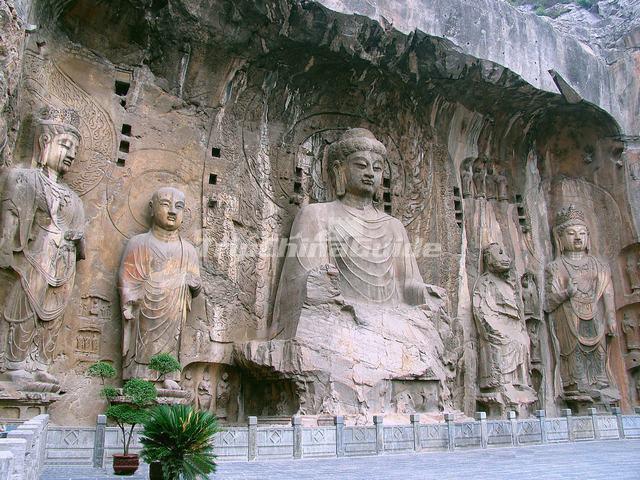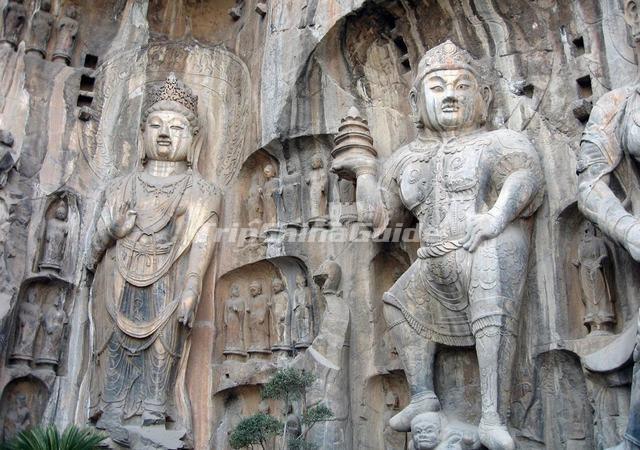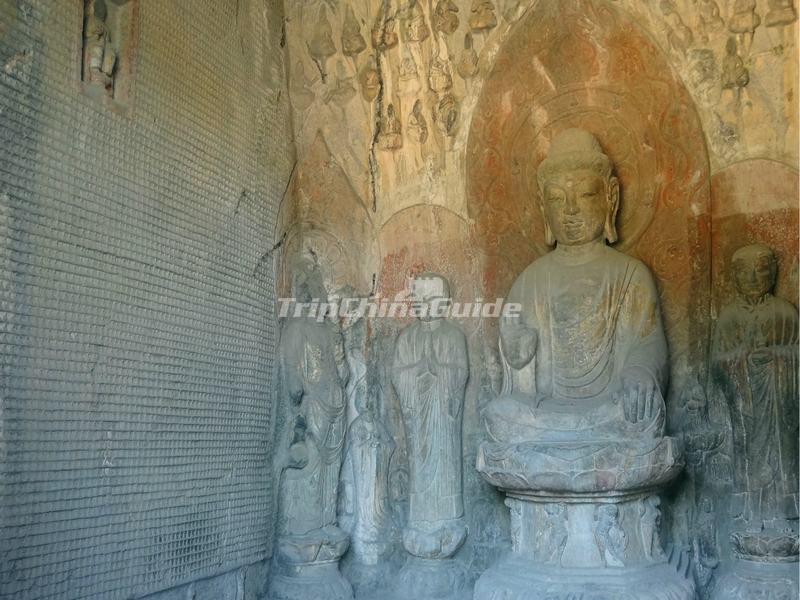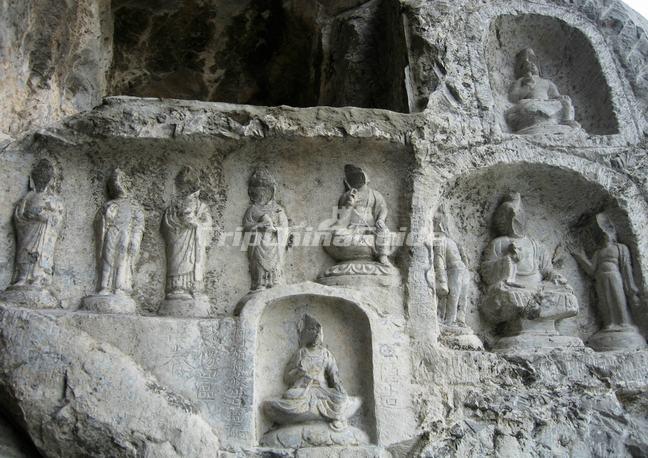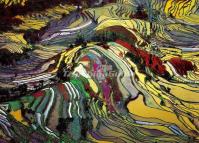Longmen Grottoes Facts
The Longmen Grottoes (literally called Dragon's Gate Grottoes) or Longmen Caves are one of the finest examples of Chinese Buddhist art. Housing tens of thousands of statues of Buddha and his disciples, they are located 12 kilometers south of present day Luoyang in Henan province, Peoples Republic of China. The images, many once painted, were carved into caves excavated from the limestone cliffs of the Xiangshan and Longmenshan mountains, running east and west. The Yi River flows northward between them and the area used to be called Yique ("The Gate of the Yi River").
There are as many as 100,000 statues within the 1,400 caves, ranging from a 1 inch to 57 feet (17 m) in height. The area also contains nearly 2,500 stelae and inscriptions, whence the name “Forest of Ancient Stele", as well as over sixty Buddhist pagodas. Situated in a scenic natural environment, the caves were dug from a 1 kilometer stretch of cliff running along both banks of the river. 30% date from the Northern Wei Dynasty and 60% from the Tang, caves from other periods accounting for less than 10% of the total. Starting with the Northern Wei Dynasty in 493 AD, patrons and donors included emperors, Wu Zetian of the Second Zhou Dynasty, members of the royal family, other rich families, generals, and religious groups.
World Cultural Heritage
In 2000 the site was inscribed upon the UNESCO World Heritage List as “an outstanding manifestation of human artistic creativity,” for its perfection of an art form, and for its encapsulation of the cultural sophistication of Tang China.
History of Longmen Grottoes
Work began on the Longmen Grottoes in 493, when Emperor Xiaowen of the Northern Wei Dynasty moved his capital to Luoyang. Over the next four centuries this work continued; it can be divided into four distinct phases.
The period between 493 and 534 was the first phase of intensive cutting of grottoes. The first cave to be carved was Guyangdong (also known as the Shiku Temple); records show that more than two hundred people were involved in the work. This marked the beginning of a major program of grotto carving by the Northern Wei rulers. Emperor Xuanwu cut three, two in memory of his father, Xiaowen and one for his mother, Wenzhao. These are the three caves now known as the Three Binyang Caves (Binyangsandong), and the work took more than 24 years to complete. A number of other caves of all sizes were cut during this period on the West Hill: they account for some 30% of the total.
This phase of intense activity was followed by a period between 524 and 626 when very few caves, and those all relatively small, were cut. This is attributable principally to the civil strife between different regions of China that persisted through the Sui Dynasty (581-618) and the early part of the Tang Dynasty (618-907).
It was not until 626 that the third phase began, during the height of the Tang Dynasty, when Chinese Buddhism had begun to flourish again. This was once again a period of intensive cutting of grottoes; it was the highpoint artistically of Longmen, especially during the reigns of Emperor Gaozang and Empress Wuzetian, who lived permanently at Luoyang. The groups of giant statues in Fengxiansi Cave are most fully representative of this phase of Chinese art at Longmen; they are generally acknowledged to be artistic masterpieces of truly global significance.
Many other grottoes of all sizes were cut at this period on both the West Hill and the East Hill. They make up some 60% of the grottoes at Longmen. In addition, a number of fine Buddhist temples were built there during the Tang Dynasty against the magnificent natural landscape. Most of these only exist now in the form of ruins, but they are still an important component of the overall Longmen cultural complex.
The final phase, from 755 to 1127, during the later Tang through to the Northern Song Dynasty, saw a steep decline in the carving of grottoes at Longmen. This began with the capture of Luoyang in the mid-8th century during a rebellion, an event from which the area never recovered. It was the outbreak of warfare during the Jin and Yuan Dynasties that brought grotto carving to an end.
In the Ming (1368-1644) and Qing (1644-1912) Dynasties, the great artistic and cultural achievement represented by the Longmen grottoes gradually received national and then international recognition, and were the subject of much scholarly study. During the 1940s some of the stone carvings were stolen and sold abroad, but since the establishment of the People's Republic of China in 1949 they have been protected and conserved and The Longmen Relics Care Agency was established in 1953 under the Ministry of Culture.
Major Attractions of Longmen Grottoes
1.Fengxiansi Cave
Located on the south floor of Longmen’s West Hill, Fengxiansi Cave, or called Fengxian Temple, was originally named “Grand Losana Buddha Niche”. Its large scale, spectacular vigor, delicate statues and highly-skilled craftsmanship make it the largest cliff-niche in Longmen Grottoes. It is also the most representative work of Longmen’s carvings in Tang Dynasty.
2.Binyang Cave
Binyang has three caves, Middle Binyang Cave, South Binyang Cave and North Binyang Cave, of which the Middle Binyang Cave is the most prominent.
3.Ten-Thousand Buddha Cave
Situated at the south of Binyang Cave, the Ten-thousand Buddha Cave has abundant statues, with numerous small Buddhist images carved on the south and north stonewalls. Many of them are as small as one inch or several centimeters in a total number of over 1500. The Buddhist statue in the main wall of the cave sits up on the octagonal lotus throne. On the waist of the throne there are four Hercules shouldering the supine lotus flowers. On the rear wall 54 lotuses are carved with a Bodhisattva or a Donor sitting on each flower. On the top of the cave are the carvings of free Flying Apsaras in relief, each with its own vivid posture and expression.
4.Lotus-Flower Cave
The Lianhua or the Lotus Flower Cave, dated to 527, belongs to be the Northern Wei period. The Grotto has a large lotus flower carved in high relief on its ceiling. Several small Buddhas are carved into the south wall. Also seen are shrines in the south and north wall in the niches.
5.Guyang Cave
Guyang Cave, 11.20 meters high, 7.27 meters wide and 11.83 meters deep, is the oldest cave with the richest contents in Longmen Grottoes. It is also a cave which houses the majority of the statues that royal members of Northern Wei made vows to build.
6.Xiangshan Temple
Xiangshan Temple, which ranked the first among the ten temples at Longmen, is situated in the middle mountainside of the East Hill. The East Longmen Hill is teemed with spices name “Xiangge”, hence the name Xiangshan. Then the temple was named Xiangshan Temple. The present Xiangshan Temple was reconstructed in about 1707, during the Qing Dynasty, bon the basis of an old temple.
7.Bai Garden Temple
Bai Garden is a temple situated on the Pipa Peak, to the north of the East Hill (Xiangshan Hill). It was re-built in 1709 by Tang Youzeng of the Qing Dynasty. The temple is surrounded by thick vegetation of pine and cypress trees.
8.Tomb of Bai Juyi
The Tomb of Bai Juyi on the east bank is the well-known poet during the Tang Dynasty rule; he lived in Luoyang during his later years. The tomb is located on the hill top. It is approached from west bank after crossing a bridge across the Yi River. The tomb is a circular mound of earth of 4 meters height with a circumference of 52 meters. The tomb is 2.80 meters high and has the poets name inscribed on it as Bai Juyi.
Entrance Fee
RMB 120
Opening Hours
07:00 to 18:30 (spring, summer, autumn)
07:30 to 17:30 (winter)
How to get to Longmen Grottoes
Visitors can take a day trip car to Longmen Grottoes at the Railway Station, or take public bus No. 81, 53, 60 (CNY 1) to Longmen Grottoes, takes about 40 minutes.
Recommended China Tour Packages
-
5-day Harbin Ice Festival & Yabuli Skiing Tour
-
5-day Yuanyang Rice Terraces Tour
-
5-day Chengdu Panda & Xiling Snow Mountain Ski Tour







